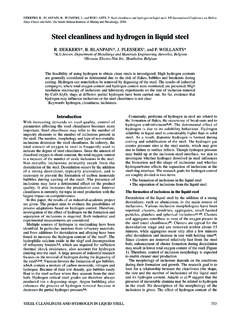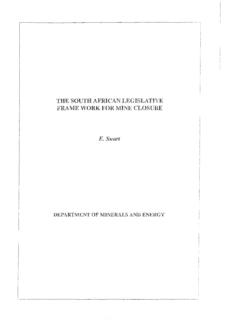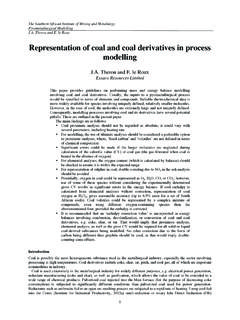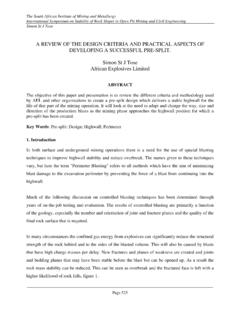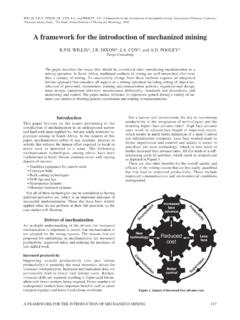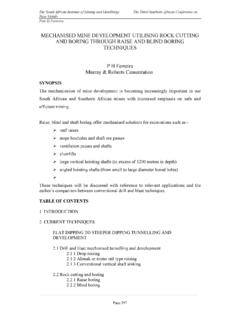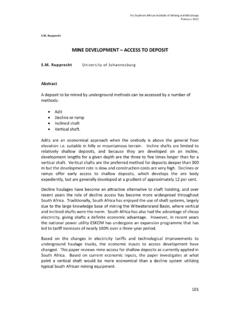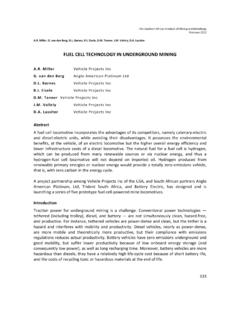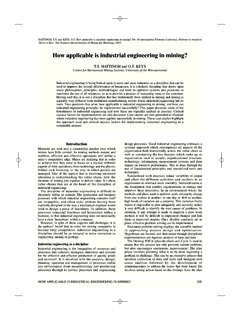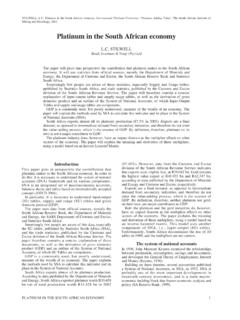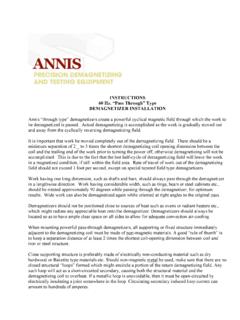Transcription of Application of magnetic separation technology for the ...
1 IntroductionIn recent years, the industrial use andimportance of boron compounds has furtherincreased with the potential Application ofboron as hydrogen carrier in the form of BH4in the exploitation of hydrogen as cleanenergy. Boron compounds can be producedfrom a variety of boron minerals and boron-rich brines. Colemanite ( ),ulexite (NaCaB5O6(OH) ) and borax(Na2B4O5(OH) ) are the most importantboron minerals of commercial is extensively used in theproduction of boric acid and preferentially inthe textile and glass industries where sodiumcontent is often undesirable1.
2 Turkey is thelargest producer of colemanite concentratesand boron Kestelek plant (Turkey), the colemaniteore produced from open pits is processed toproduce saleable colemanite concentrates ton per annually. Processing of the ore(25 35 B2O3) involves size reduction,screening, washing, scrubbing and hand-sorting stages to remove clay minerals andhence to upgrade the B2O3content of the oreto 38 45 The treatment process isrelatively inefficient since a large amount oftailings is produced with significant boronlosses (5 15 B2O3)
3 And wastemanagement problems associated with theboron release to the of more cost-effective,environmentally acceptable and simpleprocesses for the upgrading of the ore is,therefore, required to reduce the boron lossesto the tailings. Several alternative processesincluding attrition-scrubbing/classification2,3,el ectrostatic separation4, ultrasonicpretreatment5,6, thermal decomposition-decrepitation7-13, flotation14-17and leaching18-22were extensively studied to recovercolemanite from the ore and the tailings. Noneof these processes apart from attrition-scrubbing followed by classification has beenfurther developed due to their inherentshortcomings.
4 To illustrate, slime coating wasidentified to be the most severe problem,adversely affecting flotation recoverieswhereas the thermal treatment methods suchas decrepitating are energy aqueous processes using inorganicand organic acids and gas-saturated solutionsare attractive, they suffer from high reagentconsumption and expensive separation is one of the mostextensively used separation methods in themineral processing applications23-25. Weaklymagnetic minerals with low susceptibilities(<5 10-6m3kg-1)26could be readilyrecovered by high intensity magneticseparators, which can generate high magneticfields (> Tesla) and field gradients in theorders of 50 500 T m-1.
5 Flores et that, except for ulexite, which hadweakly magnetic properties, other boronApplication of magnetic separationtechnology for the processing of acolemanite oreby I. Alp*SynopsisApplication of magnetic separation was investigated for theenrichment of colemanite ores by removing the magnetic ganguefraction. The detailed XRD analysis of the ore has indicated that thegangue fraction is composed predominantly of the iron-bearingsilicates such as smectite and, to a lesser extent, illite. Magneticsusceptibility measurements of the colemanite and gangue sampleshave proved that colemanite is diamagnetic in character whereasgangue fraction is weakly paramagnetic to allow the removal of thisfraction by magnetic separation .
6 magnetic separation of the crushedand sized ore samples (-5 mm +75 m) was performed using a highintensity permanent magnetic separator. Under the test conditions acolemanite concentrate ( B2O3) was found to beproduced from the crushed ore ( B2O3) at a recovery These findings suggest that magnetic separation has greatpotential as an alternative process for the production of aconcentrate of commercially sufficient grade. *Mining Engineering Department, KaradenizTechnical University, Trabzon, Turkey. The Southern African Institute of Mining andMetallurgy, 2008.
7 SA ISSN 0038 223 + Paper received Apr. 2008; revised paperreceived Nov. Journal of The Southern African Institute of Mining and MetallurgyVOLUME 108 FEBRUARY 2009 TechnicalNote 13979-85:Template Journal 4/3/09 8:36 AM Page 139minerals including colemanite, hydroboracite and boraxshowed diamagnetic character. Clay minerals includingnontronite, biotite, illite and chlorite are often present asgangue phase in most boron ores28. The iron content of theseclay minerals is of practical importance since it largely affectstheir magnetic properties, the magnetic susceptibility ofclay minerals tend to increase with their iron content29.
8 Inthis respect, if the paramagnetic susceptibilities of clays aresufficiently high, they can respond to high magneticfields30, they can then be separated from the diamagneticboron minerals such as colemanite31-32. In this study, the potential Application of a high gradientdry rare-earth permanent magnetic roll separator for therecovery of colemanite from the ore was studied. Effect ofparticle size on the separation of colemanite from the gangueminerals was shown. The mineralogical properties of the orewith particular reference to clay minerals present wereexamined in some detail.
9 The magnetic susceptibilities ofcolemanite and gangue present in the ore were alsodetermined prior to magnetic separation tests. Materials and methodsOre sampleThe colemanite ore sample used in this study was obtainedfrom Kestelek plant in Turkey. The sub-samples wereprepared from the bulk sample for the chemical andmineralogical analyses. The mineralogical analysis of the oreusing a Rigaku DMAXIIC X-ray difractometer revealed thatthe ore was composed predominantly of colemanite as theonly boron phase detected (Figure 1). The main gangueminerals were identified to be calcite (CaCO3), dolomite(CaMg(CO3)2) and clay minerals including smectite and illite(Kx(Al,Mg)2(Si,Al)4O10(OH) ).
10 Clay fraction of the orewas separated using the procedure proposed by G ndo duand Y lmaz33for the detailed characterization of clayminerals. The XRD analyses of the clay fraction obtained(Figure 1) showed that smectite minerals occur astrioctehedral smectite of nontronite( (Si,Al)4O10(OH)2 .nH2O) and dioctehedral smectiteof montmorillonite((Na,Ca) (Al,Mg)2Si4O10(OH) )34-36. It should benoted that the XRD analyses were performed in duplicate toensure the identification of the clay phases present. Thechemical analysis of the ore sample using a Jeol X-rayfluorescence (XRF) indicated that the ore sample B2O3and Fe2O3(Table I).
